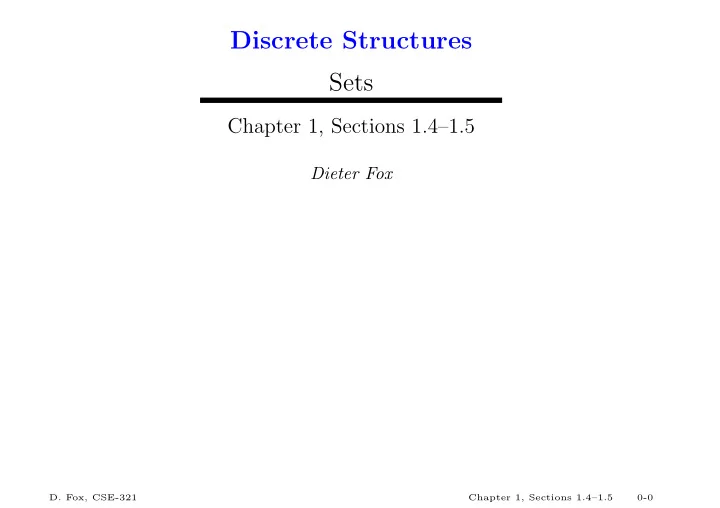

Discrete Structures Sets Chapter 1, Sections 1.4–1.5 Dieter Fox D. Fox, CSE-321 Chapter 1, Sections 1.4–1.5 0-0
Sets ♦ aǫA : Objects in a set are called elements / members of the set. ♦ Set descriptions: List all elements, set builder notation, Venn diagram ♦ A = B : Two sets A and B are equal if and only if they the same elements. ♦ A ⊆ B : The set A is subset of B if and only if every element of A is also an element of B . ♦ A ⊂ B : The set A is called proper subset of B if A ⊆ B and A � = B . ♦ | S | : If there are exactly n distinct elements in S where n is a nonnegative integer, we say that S is a finite set and that n is the cardinality of S . A set is said to be infinite if it is not finite. D. Fox, CSE-321 Chapter 1, Sections 1.4–1.5 0-1
Sets ♦ P ( S ) : The power set of S is the set of all subsets of the set S . ♦ The ordered n-tuple ( a 1 , a 2 , . . . , a n ) is the ordered collection that has a 1 as its first element, a 2 as its second element, . . . , and a n as its nt th element. ♦ A × B : The Cartesian product of A and B is the set of all ordered pairs ( a, b ) where aǫA and bǫB . ♦ A 1 × A 2 × . . . × A n : The Cartesian product of the sets A 1 , A 2 , . . . , A n is the set of ordered n − tuples ( a 1 , a 2 , . . . , a n ) , where a i belongs to A i for i = 1 , 2 , . . . , n . D. Fox, CSE-321 Chapter 1, Sections 1.4–1.5 0-2
Set operations ♦ A ∪ B : The union of A and B is the set that contains all elements that are in A or in B . ♦ A ∩ B : The intersection of A and B is the set that contains all elements that are in both A and B . ♦ Two sets are called disjoint if their intersection is the empty set ( ∅ ). ♦ A − B : The difference of A and B is the set containing those elements that are in A but not in B . The difference of A and B is also called the complement of B wrt. A . ¯ ♦ A : Let U be the universal set. The complement of A is the complement of A wrt. U . ♦ The union (intersection) of of a collection of sets is the set that contains those elements that are member of at least one (all) set(s) in the collection. D. Fox, CSE-321 Chapter 1, Sections 1.4–1.5 0-3
Set identities A ∩ U = A Identity laws A ∪ ∅ = A A ∪ U = U Domination laws A ∩ ∅ = ∅ A ∪ A = A Idempotent laws A ∩ A = A ( A ) = A Double negation law A ∪ B = B ∪ A Commutative laws A ∩ B = B ∩ A ( A ∪ B ) ∪ C = A ∪ ( B ∪ C ) Associative laws ( A ∩ B ) ∩ C = A ∩ ( B ∩ C ) A ∪ ( B ∩ C ) = ( A ∪ B ) ∩ ( A ∪ C ) Distributive laws A ∩ ( B ∪ C ) = ( A ∩ B ) ∪ ( A ∩ C ) ( A ∩ B ) = A ∪ B De Morgan’s laws ( A ∪ B ) = A ∩ B D. Fox, CSE-321 Chapter 1, Sections 1.4–1.5 0-4
Recommend
More recommend